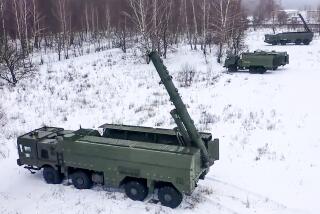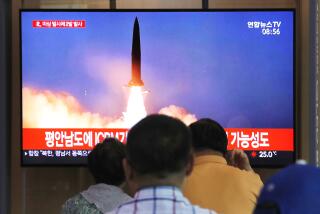Desert Games Test India’s Army : It’s Not a 3rd World Force Now; Parallels With Past Seen
- Share via
BIKANER, India — “Blueland” attacked “Redland” in the Great Indian Desert, with armored columns moving swiftly toward Bikaner, scattering herds of gazelles and feral camels.
MIG-21 fighter planes and Hind helicopter gunships dived out of the hazy blue sky, and on the ground more than 150,000 men slogged through the sand.
Operation Brass Tacks, the largest military exercise ever in South Asia, was under way Thursday between two theoretically non-existent countries.
Military authorities likened the scale of the exercise, involving hundreds of tanks and aircraft, to the largest war games carried out in Europe by forces of the North Atlantic Treaty Organization.
Comic Relief Provided
There were unplanned moments of comic relief. Camel cart drivers found themselves at the head of lines of impatient tank commanders moving along narrow dirt roads. In Bikaner, cows were seen browsing on camouflage netting. At the control center, a pair of sparrows went noisily about their business of building a nest in a light fixture over the master battle map.
Military officers denied the correlation, but it did not take much imagination to see that Blueland represents India and Redland the archenemy Pakistan. India and Pakistan have fought three wars, and Operation Brass Tacks is clearly a rehearsal for the possibility of another.
The mock battle is taking place in part along a north-south corridor 100 miles from the border with Pakistan. “But all you have to do,” an Indian journalist quipped, “is turn the map on its side, and you can see it’s India against Pakistan.”
There are other parallels. In the war of 1965, Pakistan attacked in the disputed region of Jammu and Kashmir, and India counterattacked in the Pakistan Punjab. On Thursday, the forces of Redland were attacking New Delhi, the Indian capital, and Blueland’s were counterattacking south of Bikaner.
Strong, Modern Army
Today’s Indian army, 1 million strong, has little in common with the Indian army of 1965. In 25 years, military experts say, it has developed into one of the world’s finest and most modern armies.
Never before, according to Western diplomats, has the land-forces balance been so heavily in favor of India over Pakistan.
“This is not a Third World army anymore,” one diplomat said. “This is a modern army fully competent to fulfill any mission.”
For Operation Brass Tacks, which is expected to continue until March 15, India has fielded for the first time an entirely mechanized division. It is equipped with Soviet T-72 tanks and high-speed armored personnel carriers.
Also involved are mechanized infantry teams equipped with tanks, armored personnel carriers, artillery and air-defense rocket systems.
On display as well are MI-24 Hinds, helicopter gunships obtained over the past two years from the Soviet Union, India’s main weapons supplier.
Favors Mobile Tactics
Although the new equipment is mostly of Soviet design, the theory behind the computer-directed forces is based on the U.S. Army model. The Indian army chief of staff, Gen. Krishnawami Sundarji, is a graduate of the U.S. Army Command and Staff College at Ft. Leavenworth, Kan., and is known to favor the mechanized mobile infantry approach used in the United States.
In a press conference at Bikaner, Sundarji said the force taking part in Operation Brass Tacks reflects an army in transition from the concepts of World War II.
“From time to time,” he said, “one has to update tactics and organizations. We stayed with World War II organization for all those years,” and the time has come to move on to “pure mobile warfare.”
Sundarji denied that modernization of the army has changed the balance of power in South Asia in favor of India over Pakistan. Like most Indian officers, he argued that India needs superior forces because it is forced to plan for a short war from a defensive posture. In a long war, he said, India would clearly dominate, but a long war is not likely on the subcontinent.
Pakistani Army Smaller
The Pakistani army is less than half the size of India’s and does not have mechanized units to match India’s, but Sundarji said India needs the greater number of men and units in order to defend its border with China as well.
Sundarji confirmed that Operation Brass Tacks was delayed for several days because of a military mobilization in Pakistan in late January. He said this may have been caused by “gross misperception” of Operation Brass Tacks by Pakistani military men.
But Western diplomats interpreted it as more of a sign of Pakistani uneasiness over the growing military imbalance. It is this perceived uneasiness that is said to lie behind renewed speculation about a Pakistani nuclear weapon.
Pakistan’s top nuclear scientist, Abdul Qadeer Khan, is reported to have said not long ago, in an interview with Indian journalist Kuldip Nayar and Pakistani editor Mushahid Hussain, that Pakistan has already developed a nuclear weapon.
“America knows it,” Nayar quoted Khan as saying. “What the CIA has been saying about our possessing the bomb is correct, and so is the speculation of some foreign newspapers.”
If Pakistan has a nuclear weapon, it radically alters the balance of power with India, and India may feel forced to develop a nuclear weapon of its own. That India has the capability to do so was demonstrated in 1974, when it detonated a nuclear device in the Rajasthan desert.
Also, if Pakistan has such a weapon, it could threaten a proposed $4-billion U.S. aid program for Pakistan.
More to Read
Sign up for Essential California
The most important California stories and recommendations in your inbox every morning.
You may occasionally receive promotional content from the Los Angeles Times.













